Six
Eye-Centered Portraits, 2006
by Devorah Sperber
Medium: Thousands of spools of thread,
clear viewing spheres
Dimensions: 104"- 122" h x 100"w (each work)
I am interested in the link between art, science, and technology, how the eyes and brain prioritize, and reality as a subjective experience vs. an absolute truth. As a visual artist, I cannot think of a topic more stimulating and yet so basic, than the act of seeing--how the human brain makes sense of the visual world. -- Devorah Sperber
After Renoir, 2006
Based
on A Girl With a Watering Can, (1876) by Pierre-Auguste Renoir
National Gallery of Art, Washington DC
At first glance, the installations appear to be a random arrangement of spools of thread. Clear acrylic spheres placed in front of the works, shrink and condense the thread spool "pixels" into recognizable images while also rotating the imagery 180 degrees like the human eye. This shift in perception functions as a dramatic mechanism to present the idea that there is no one truth or reality, emphasizing subjective reality vs. an absolute truth.
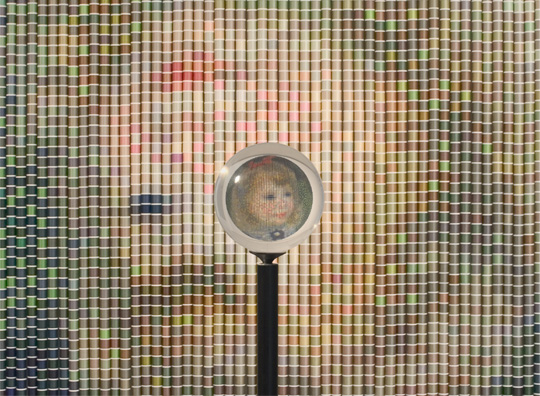
Detail View: "After Renoir," 2006, by Devorah Sperber, 5,024 spools of thread, stainless steel ball chain and hanging apparatus, clear acrylic viewing sphere, metal stand (104"-122" h x 100” w x 72"- 84” d)
After Renoir is one of six thread spool works which are based on the centered-eye phenomenon in historical portraits. The other five works are based on portraits by da Vinci, Vermeer, Picasso, Rembrandt, & Van Eyck. This concept was inspired by a recent scientific survey by Christopher Tyler of 3/4 view portraits over the past two millennia which revealed that one eye tended to be placed symmetrically at or near the vertical axis of the canvas throughout the history or Western portraiture. While Renoir's A Girl With a Watering Can did not meet the criteria of Tyler's study (he only surveyed portaits from the waist up), the symmetry, soft focus, and color scheme compelled me to select it as a subject matter.
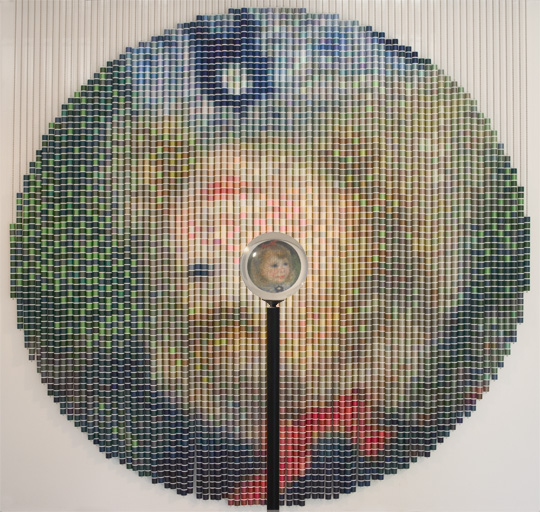
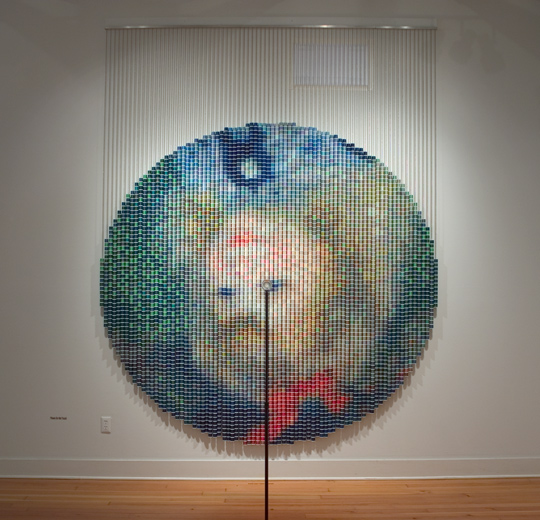
After Picasso, 2006
Based
on the portrait Gertude Stein, (1906) by Pablo Picasso
The
Metropolitan Museum of Art, New York
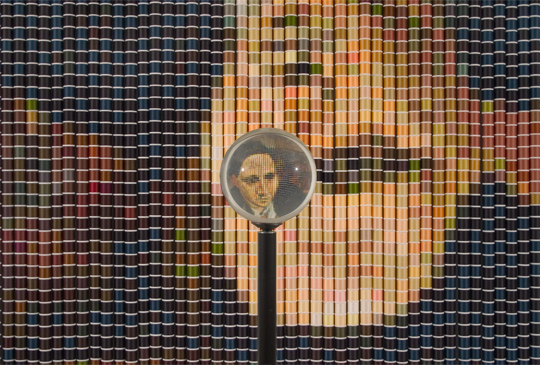
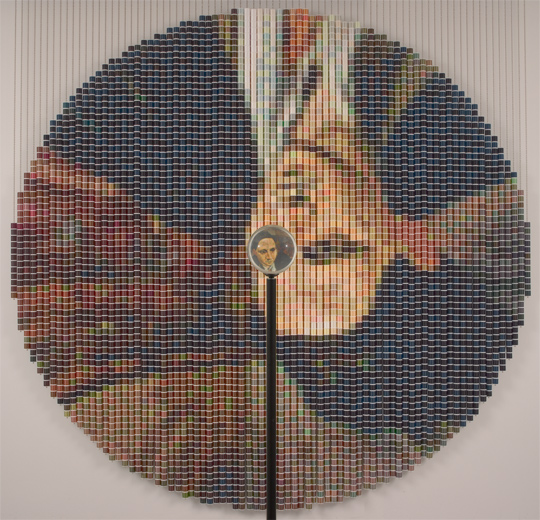
After Rembrandt, 2006
Based
on Self Portrait, (1659) by Rembrandt van Rijn
National
Gallery of Art, Washington DC
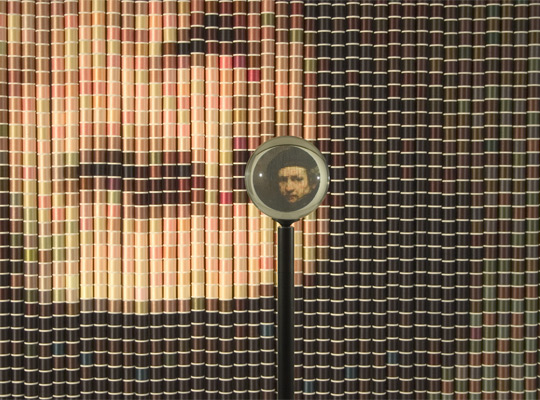
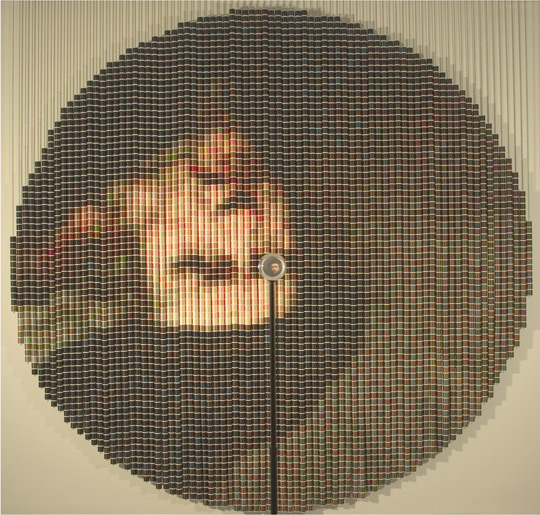
After van Eyck, 2006
Based
on Man in a Red Turban, (1443) by Jan van Eyck
National
Gallery of Art, London
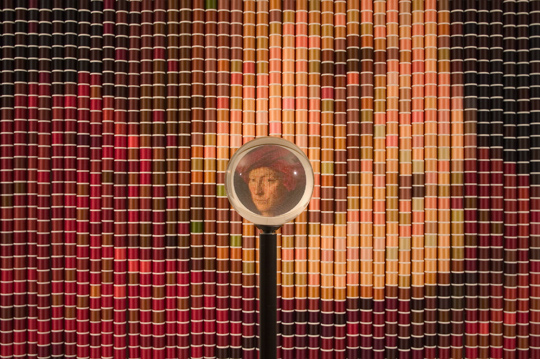
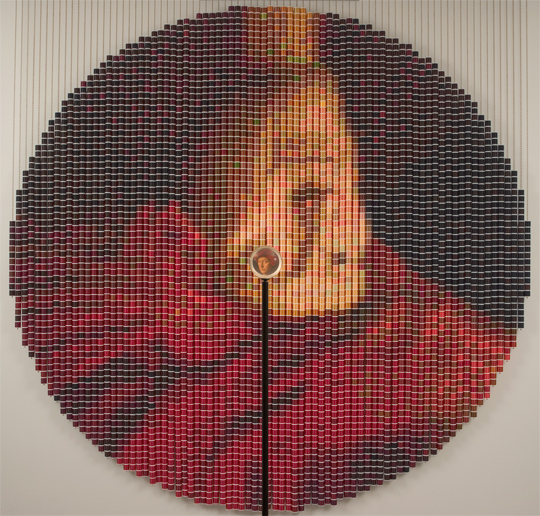
After Vermeer 2, 2006
Based
on The Girl with a Pearl Earring, (1665-1666) by Johannes Vermeer
Royal
Cabinet of Paintings Mauritshuis, The Hague
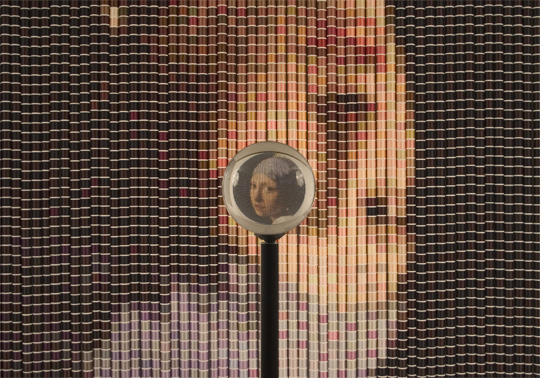
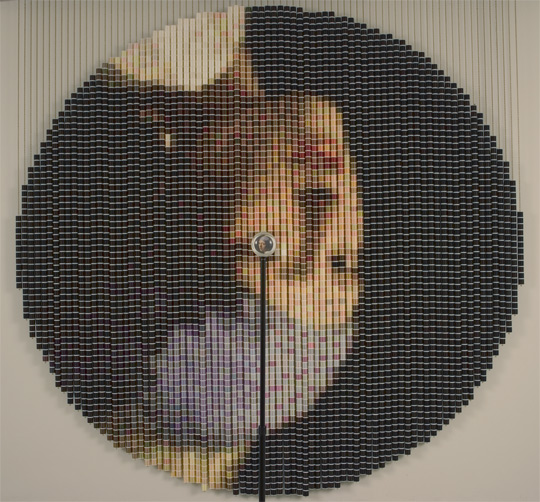
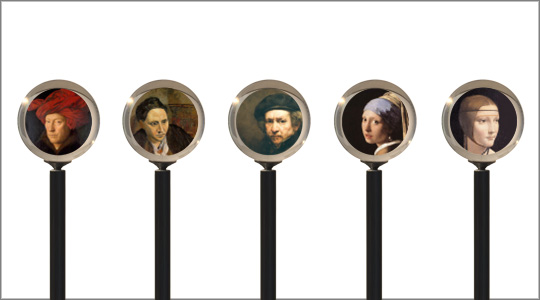
Digital Rendering: Five eye-centered portraits (as seen in viewing sphere), Medium: thousands of spools of thread (not seen in digital rendering)
Artist Statement
My current body of work consists of sculptures assembled from thousands of ordinary objects -spools of thread, marker-pen caps, map tacks, or chenille stems, combined with optical devices such as clear acrylic viewing spheres, convex mirrors, or reversed binoculars. While many contemporary artists utilize digital technology to create high-tech works, I strive to "dumb-down" technology by utilizing mundane materials and low-tech, labor-intensive assembly processes. I place equal emphasis on the whole recognizable image and how the individual parts function as abstract elements, selecting materials based on aesthetic and functional characteristics as well as for their capacity for a compelling and often contrasting relationship with the subject matter.
My interest in the biology of vision grew from my desire to understand how viewers experience my work. The six eye-centered portraits illustrate specific visual experiences related to the biology of vision such as: how the human eyes and brain process sensory data-- Photons bouncing off the spools of thread reach our eyes where they are turned into a pattern that is sent to the primary visual cortex where the rough shapes are recognized. The pattern is then sent to higher regions where colors are recognized and where thread spool identities are encoded along with other knowledge we already has about thread spools. This direction of flow is called: feed forward, meaning the data is moving from bottom to top (eyes to brain).
Bundles of nerve cells carry information. Traffic flowing from top to bottom is called feedback or top-down processing. There are 10 times as many nerve fibers carrying information down as there are carrying it up. So what we see is based on what neuroscientists call "top down processing." And what we see depends on the framework built by past experience that interprets raw data.
When the top (or brain) is convinced it knows what it is seeing (in this case, initially fixating on what appears to be a random arrangement of thread spools), the bottom level of data (the recognizable portrait) is overruled. This may explain why my use of thread spools create such a jolt or 'WOW" experience when the viewer finally sees the representation imagery in the viewing sphere, as the brain abruptly shifts focus from the individual spools to the whole recognizable image.
The brain can only hold or assemble one image at a time, so its initial fixation on the individual spools does not allow the recognizable portrait to emerge until the thread spools are seen through the viewing sphere or from a significant distance. However, once the viewer "sees" the image in the thread, the brain can shift back and forth from focusing on the individual spools to the whole recognizable image. And once the viewer "knows" the image is visible in the thread, he or she can not erase it. Thus, these works function as neurological primers, literally priming or teaching the brain to make sense of visual imagery it has not yet been exposed to.
Overall, the eye-centered portraits exemplify my interest in visual perception, the link between art, science, and technology, repetitive processes, truth of materials, the feminist art proposition of bringing genres into "high art," and the scientific systems theory which focuses on the whole as well as its part to gain understanding. - Devorah Sperber, 2006
*Partial funding by Coats and Clark
Devorah Sperber is a New York-based artist whose sculptures, composed of thousands of ordinary objects, negotiate a terrain between low and high tech. Her labor-intensive works explore repetition and the effects of digital technology on perception, scale, and subjective reality. -Patricia Phillips, Executive Editor, Art Journal
© Devorah Sperber Inc. 2000